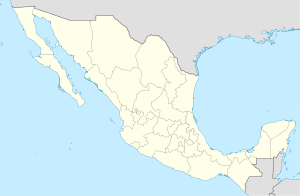Zumpahuacán facts for kids
Quick facts for kids
Zumpahuacán
|
|
|---|---|
| Country | |
| State | Mexico State |
| Municipality | Zumpahuacán Municipality |
| Elevation | 1,660 m (5,450 ft) |
| Time zone | UTC-6 (Central (US Central)) |
| • Summer (DST) | UTC-5 (Central) |
Zumpahuacán is a town in the State of Mexico. It is also the main town, or municipal seat, of Zumpahuacán Municipality.
The name "Zumpahuacán" comes from the Nahuatl language. It means "place of coral trees." These are special trees called Erythrina coralloides. Another idea for the name's meaning is "place of the skulls of the sacrificed." The welcome sign for the town uses this second meaning.
Contents
History of Zumpahuacán Town
Early Beginnings: Ancient Settlements
Studies show that people have lived in this area for a very long time. Humans were here at least 8,000 years before the Common Era (BCE). These early people had links to cultures from what is now the state of Oaxaca. Later, they connected with cultures from the central plains of Mexico.
The first village was in a place now called Pueblo Viejo, or "old village." It was also known as San Juan Viejo or Quilocán. This spot was flat, surrounded by rocky cliffs, and near the Temozolapa River. It was about seven kilometers from where the modern town is today.
Historians believe the Mexicas or Chichimecas founded this first settlement. Around 1300 to 1400 CE, Matlatzinca people joined them. Between 1464 and 1467, the Aztec Empire took control of the area. This happened under the rule of Axayacatl.
Founding the Modern Town
The modern town of Zumpahuacán started in 1550. The original village of Quilocán moved to this new spot. It was renamed "San Juan Viejo" to help spread Christianity. Alonso de la Serna was in charge of this move.
In 1565, the parish church was built. Pedro Ponce de León oversaw its construction. The town's name changed to Zumpahuacán in 1689. This happened after people asked for it, especially after land was shared differently in the area.
Challenges and Changes
Zumpahuacán faced tough times with diseases. A smallpox outbreak happened in 1841. Then, cholera hit in 1850, which almost wiped out everyone.
For a while, Zumpahuacán was part of other municipalities. It belonged to Malinalco until 1861. Then it became part of Tenancingo. In 1875, Zumpahuacán became its own municipality. Lucio Manuel Peña was its first municipal president.
A Step Towards Revolution
On February 2, 1894, an important event happened in the town. Felipe Castañeda G. was executed by a firing squad. He wrote something called the "Proclamation of Zumpahuacán." This document was one of the first to speak out against the government of Porfirio Díaz. It was a sign of the coming Mexican Revolution. Later, the town supported the Liberation Army of the South.
According to a 2005 census, the town of Zumpahuacán had 4,232 people living there.
About Zumpahuacán Municipality
Communities and Population
The town of Zumpahuacán is the main center for many smaller communities around it. These include places like Ahuacatlán, San Pablo Tejalpa, Santa María la Asunción, and many others.
In 2005, the total population of the entire municipality was 16,149 people. The municipality covers a total area of 201.54 square kilometers.
Geography and Landscape
Zumpahuacán is located on a volcanic axis. This means it has many mountains, valleys, hills, and dips in the land. Some of the highest points are Totsquilla, at 2,800 meters above sea level, and Santiago or San Miguel, at 2,780 meters. These high points are a result of past volcanic activity in the region.
The area is also part of the Balsas River watershed. This means it has many natural freshwater springs. It also has ravines that flow with water during certain seasons.
Economy and Daily Life
More than 80% of the money-making activities in the municipality come from farming. Agriculture is the main way people earn a living here.
See also
 In Spanish: Zumpahuacán para niños
In Spanish: Zumpahuacán para niños


